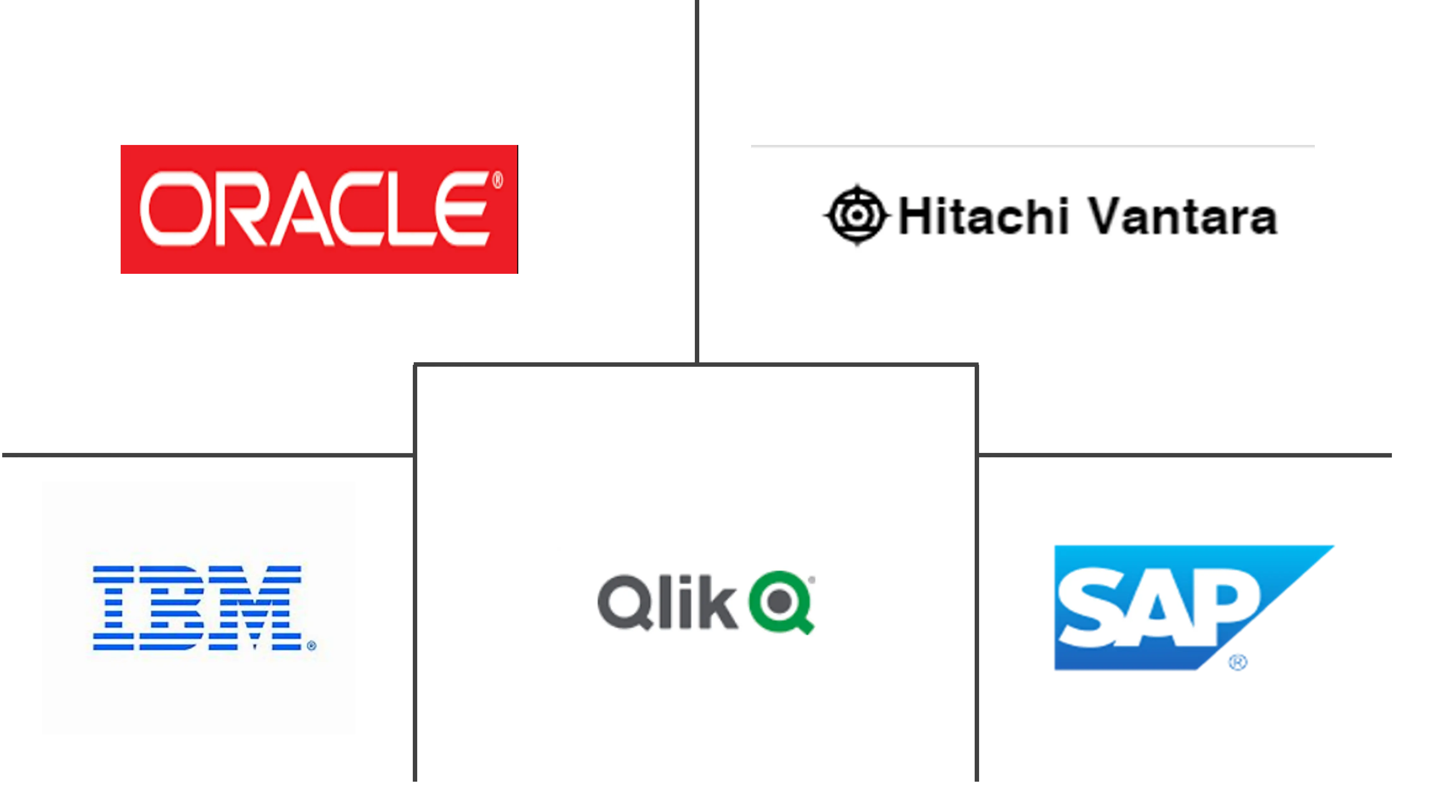Big Data Analytics in Retail Market Size and Share
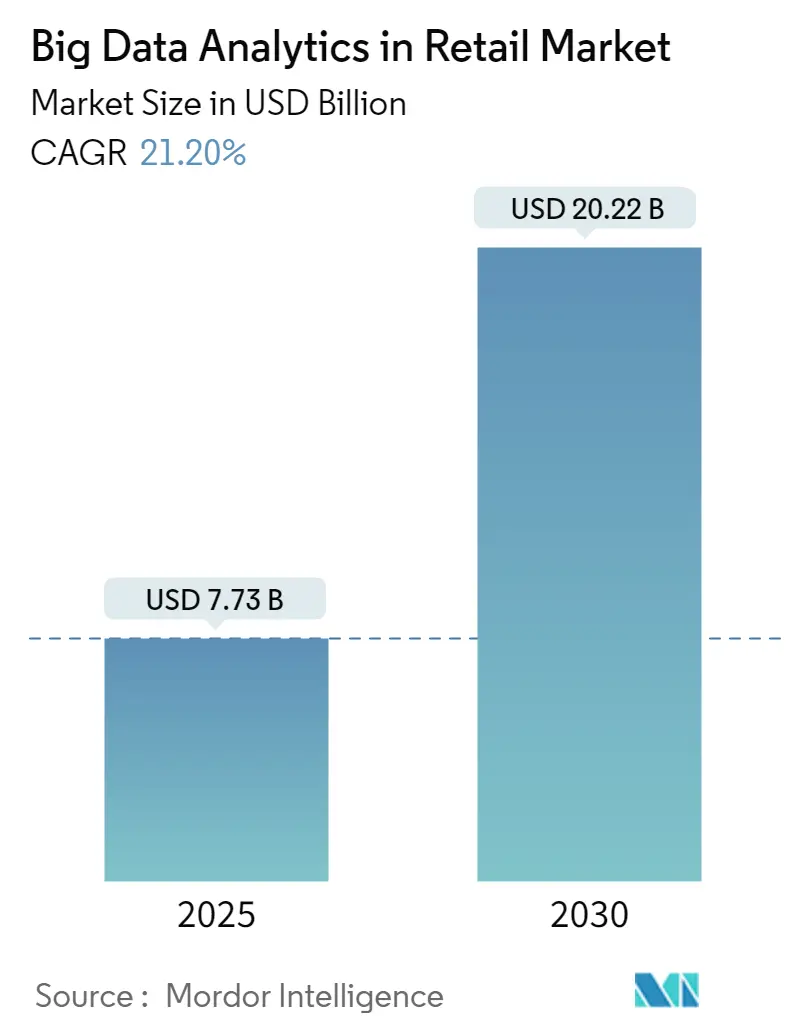
Big Data Analytics in Retail Market Analysis by Mordor Intelligence
The Big Data Analytics in Retail Market size is estimated at USD 7.73 billion in 2025, and is expected to reach USD 20.22 billion by 2030, at a CAGR of 21.2% during the forecast period (2025-2030).
The retail industry is witnessing a major transformation through advanced analytics and Big Data technologies. With the growth of e-commerce, online shopping, and high competition for customer loyalty, retailers are utilizing Big Data analytics to stay competitive in the market.
- The retail industry witnessed a steady adoption of cloud, AI, and related technologies and is considered one of the top sectors in terms of growth. According to a survey by NASSCOM, 70 percent of the companies said they focus on revenue growth by leveraging AI and increasing their spending. For Example, Walmart, one of the largest retailers in the world, is undergoing a digital transformation. It is in the process of building the world's largest private cloud system, which is expected to have the capacity to manage 2.5 petabytes of data every hour.
- Predictive analytics is a proactive approach whereby retailers can use data from the past to predict expected sales growth due to changes in consumer behaviors and market trends. It can help retailers stay ahead of the curve, compete effectively, and gain considerable market share. Increased Emphasis on Predictive Analytics which can help increase promotional effectiveness, drive cross-selling, and much more to build sustainable relationships with the customers.
- Retailers attempt to find innovative ways to draw insights from the ever-increasing amount of structured and unstructured information about consumer behavior. Retailers, both offline and online, are adopting the data-first strategy toward understanding their customers' buying behavior, mapping them to products, and planning marketing strategies to sell their products to increase profits by applying Big Data Analytics at every step of the retail process. Innovative ways such as Implementing IPS systems, Store Automation with self check out, Robots, and Automation in retail, etc., drive the need for Big data analytics in the retail market.
- Data integration challenges could restrain the market, including data governance, scalability, and problems associated with getting data from multiple sources to have data duplication and transformation rules. However, these can be reduced with the proper systematic set of rules.
- The COVID-19 pandemic hugely impacted retail markets at the regional and country level due to the shutdown of factories, and manufacturing plants, increase in prices, strict lockdowns, and supply chain disruptions as people's mobility were confirmed to their homes. However, post-pandemic considering the inherent human needs, Big Data is helping retailers to cater to customers in a more personalized way via targeted advertising, product recommendations, and pricing; the retailers increasingly prefer the technology.
Global Big Data Analytics in Retail Market Trends and Insights
Merchandising and Supply Chain Analytics Segment Expected to Hold Significant Share
- E-commerce has impacted traditional brick-and-mortar retailers, reducing their significance and marking the data-driven revolution in the retail sector. An efficient supply chain, the optimized movement of goods from supplier to warehouse to store to the customer, is critical to every business. Therefore, big data analytics is at the core of revolutionizing the retail supply chain, i.e., tracking and tracing product flow and stock levels in real-time, leveraging customer data to predict buying patterns, and even using robots to fulfill orders in vast automated warehouses tirelessly.
- Retailers must stay proactive and quickly fulfill customer needs as the retail industry continues to evolve with the integration of merchandising analytics and digital solutions. In the United Kingdom, the supply chain Big Data analytics for retail is expected to grow significantly over the forecast period, following the manufacturing and energy sector. It is further expected that predictive analytics and machine learning AI will revolutionize the retail supply chain.
- Leveraging advanced merchandising analytics is proven to help retailers overcome the challenges to thrive in an omnichannel retail world. According to the survey conducted by MIT Technology Review Insights for Big Data Analytics using cases in the consumer goods and retail industry worldwide predicts that 48 percent of respondents from the consumer goods and retail industry state that deployment of artificial intelligence can help improve customer care, followed by Quality control (47%), Inventory Management(47%), personalization of products, pricing, and fraud detection.
- As the global economy becomes interconnected and complex, companies find it challenging to meet customer expectations. They must make supply chain decisions faster, more decisive, and more accurate and can implement those decisions rapidly and transparently. Integrated demand planning is necessary to remain competitive in today's marketplace. Further, to achieve OTIF (On-Time-In-Full), a company must have end-to-end supply chain visibility and be able to balance demand and supply in real-time to make the right decisions quickly and effectively. Improving customer satisfaction, optimizing inventory levels and distribution networks, and achieving a faster time to market for sales maximization prove the need for big data Analytics in this sector.
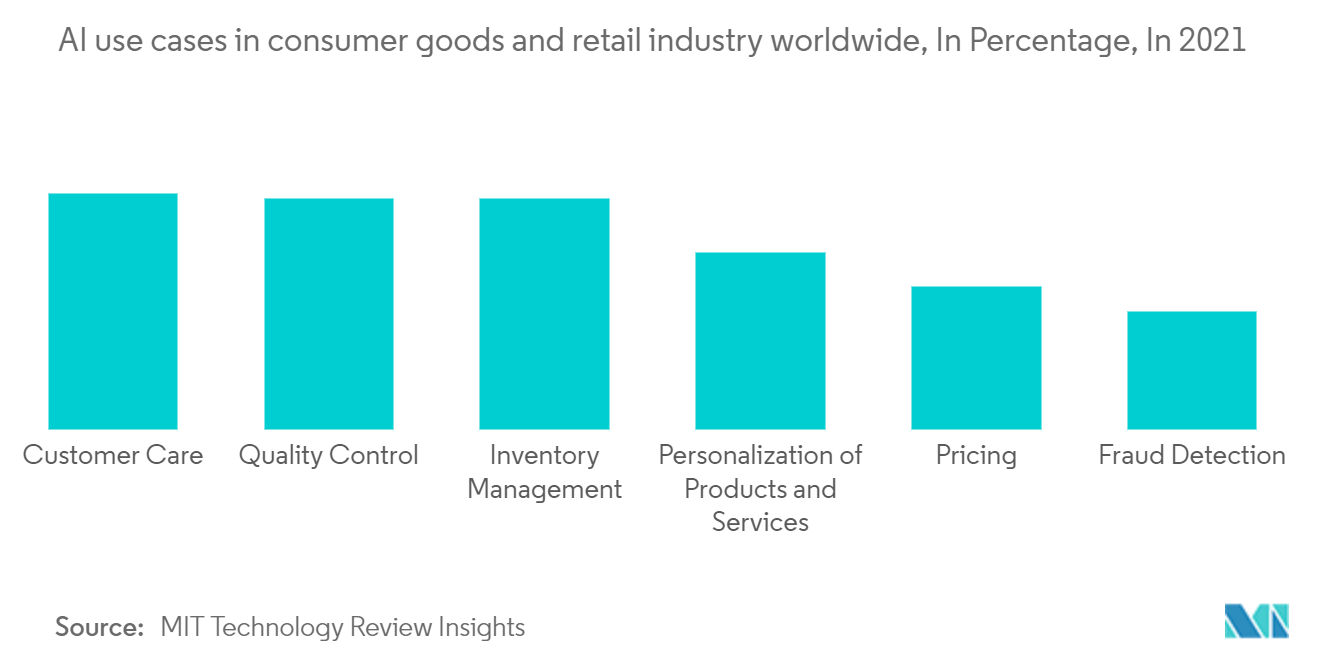
North America Region Expected to Hold the Largest Share
- Big data analytics in retail helps companies to generate customer recommendations based on their purchase history. It results in an improved ability to offer customized shopping experiences and enhanced customer service. These data sets are available in massive volumes and aid in forecasting trends and making strategic decisions guided by data. The growth of North America's big data analytics in the retail market is driven by the rising demand for retail analytics tools and the usage of the IoT in retail processes, enhancing the productivity and efficiency of the retail industry.
- The region's massive retail industry is experiencing growth in sales. In the United States, according to the National Retail Federation (NRF), retail sales are expected in between 6% to 8% to more than USD 4.44 trillion in the last year, citing high consumer confidence, low unemployment, and rising wages and clear signs of a strong and resilient economy.
- Besides, North America is among the leading innovators and pioneers, in terms of the adoption, of Big Data analytics. The region boasts a strong foothold of Big Data analytics vendors, which further contributes to the market's growth. Some include IBM Corporation, SAS Institute Inc., Alteryx Inc., and Microstrategy Incorporated. Big data analytics hardware, software, and services need more significant expenditures due to the rise in data production and retail consumption with corresponding sales increases.
- The increasing adoption of industry 4.0 across the retail sector is one of the primary aspects encouraging market growth. In retail 4.0, several operations and processes in the retail industry, like inventory management, customer service, customer accounts, supply chain management, and merchandising management activities, became digitized and automated. It is further expected to bolster the growth of North America's big data analytics in the retail market during the forecast period.
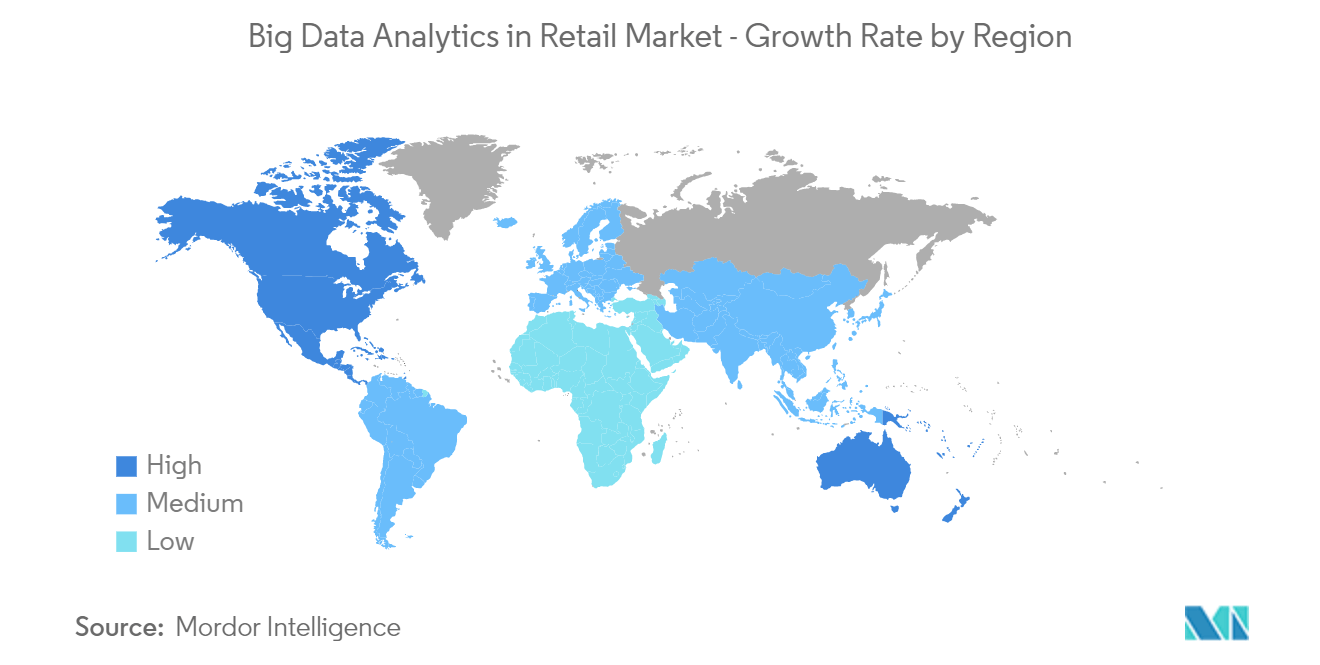
Competitive Landscape
Big data analytics in the retail market is moderately to highly fragmented. The growth of e-commerce, online shopping, and high competition for customer loyalty provides lucrative opportunities in big data analytics in the retail market. Overall, the competitive rivalry among existing competitors is high. Moving forward, different kinds of innovation strategies of large companies boost market growth effectively.
In August 2022, Maxis took a significant stake in Malaysian-based retail analytics startup, ComeBy, to empower innovation and digitalization in the retail industry with greater access to technology and the human network to create more economic multipliers for the country.
Also, in August 2022, DataWeave, an AI-powered Brand Analytics solution company, announced its status as a vetted partner in the Amazon Advertising Partner Network to support brands in optimizing their digital advertising campaigns with actionable data insights. The Amazon Advertising Partner Network, and new Partner Directory, provide brands access to a global community of agencies and tool providers that can help advertisers achieve their business goals using Amazon Ads products.
Big Data Analytics in Retail Industry Leaders
-
SAP SE
-
Oracle Corporation
-
IBM Corporation
-
Hitachi Vantara Corporation
-
Qlik Technologies Inc.
- *Disclaimer: Major Players sorted in no particular order
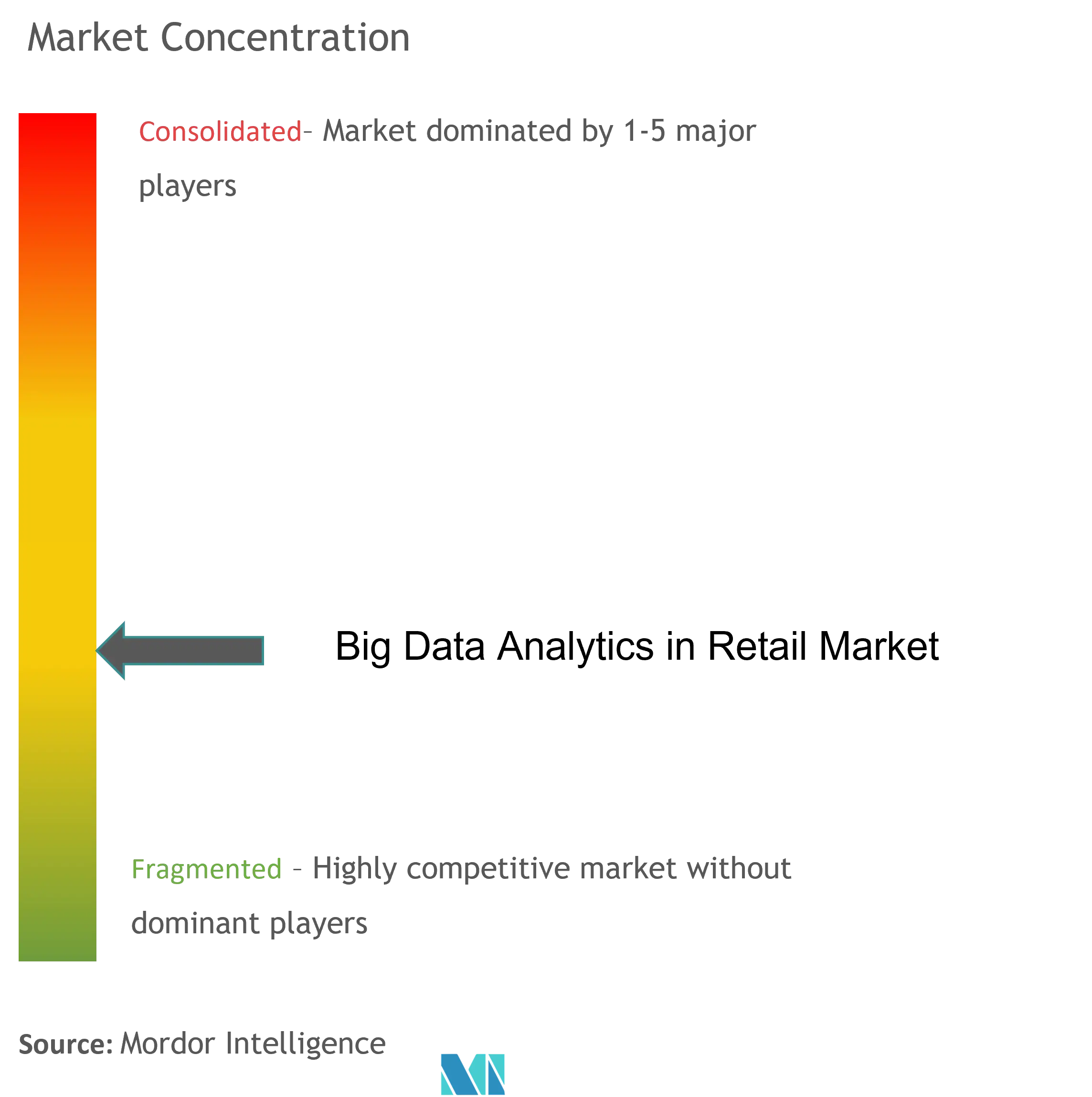
Recent Industry Developments
- September 2022 - Coresight Research, a global provider of research, data, events, and advisory services for consumer-facing retail technology and real estate companies and investors, acquired Alternative Data Analytics, a leading data strategy, and insights firm. This acquisition will significantly increase data capabilities and further extend expertise in data-driven research.
- August 2022 - Global Measurement and Data Analytics company Nielsen and Microsoft launched a new enterprise data solution to accelerate innovation in retail using Artificial Intelligence data analytics to create scalable, high-performance data environments.
Global Big Data Analytics in Retail Market Report Scope
Big Data analytics is used at every retail stage to understand customer behavior, predict demand, and optimize pricing. In terms of application, Big data offers machine learning and artificial intelligence algorithms that can speed up business decision-making, discover patterns in data sets and optimize and streamline business processes to fatten up those thin margins in the retail sector.
The Big Data Analytics in the Retail Market is segmented by Application ( Merchandising and Supply Chain Analytics, Social Media Analytics, Customer Analytics, Operational Intelligence, and Other Applications), Business Type (Small and Medium Enterprises, Large-scale Organizations), and Geography. The market sizes and forecasts are provided in terms of value (USD billion) for all the above segments.
| Merchandising and Supply Chain Analytics |
| Social Media Analytics |
| Customer Analytics |
| Operational Intelligence |
| Other Applications |
| Small and Medium Enterprises |
| Large-scale Organizations |
| North America |
| Europe |
| Asia-Pacific |
| Rest of the World |
| By Application | Merchandising and Supply Chain Analytics |
| Social Media Analytics | |
| Customer Analytics | |
| Operational Intelligence | |
| Other Applications | |
| By Business Type | Small and Medium Enterprises |
| Large-scale Organizations | |
| Geography | North America |
| Europe | |
| Asia-Pacific | |
| Rest of the World |
Key Questions Answered in the Report
How big is the Big Data Analytics in Retail Market?
The Big Data Analytics in Retail Market size is expected to reach USD 7.73 billion in 2025 and grow at a CAGR of 21.20% to reach USD 20.22 billion by 2030.
What is the current Big Data Analytics in Retail Market size?
In 2025, the Big Data Analytics in Retail Market size is expected to reach USD 7.73 billion.
Who are the key players in Big Data Analytics in Retail Market?
SAP SE, Oracle Corporation, IBM Corporation, Hitachi Vantara Corporation and Qlik Technologies Inc. are the major companies operating in the Big Data Analytics in Retail Market.
Which is the fastest growing region in Big Data Analytics in Retail Market?
Asia Pacific is estimated to grow at the highest CAGR over the forecast period (2025-2030).
Which region has the biggest share in Big Data Analytics in Retail Market?
In 2025, the North America accounts for the largest market share in Big Data Analytics in Retail Market.
What years does this Big Data Analytics in Retail Market cover, and what was the market size in 2024?
In 2024, the Big Data Analytics in Retail Market size was estimated at USD 6.09 billion. The report covers the Big Data Analytics in Retail Market historical market size for years: 2021, 2022, 2023 and 2024. The report also forecasts the Big Data Analytics in Retail Market size for years: 2025, 2026, 2027, 2028, 2029 and 2030.
Page last updated on:
Big Data Analytics in Retail Market Report
The Big Data Analytics in Retail Market is witnessing remarkable growth, fueled by the demand for personalized customer experiences and the booming e-commerce sector. Retailers are utilizing big data analytics to understand customer behavior and shopping patterns, enhancing customer service, retention, and satisfaction. This market, segmented by components, deployment, organization size, and application, is seeing a surge in software and cloud-based solutions across various enterprises. Innovations are spurred by integrating Internet of Things (IoT), Artificial Intelligence (AI), and machine learning, improving fraud detection, supply chain management, and predictive analytics. North America dominates the market due to its technological advancements and major industry players, while Asia-Pacific is expected to see rapid growth due to rising e-commerce popularity, fast internet, and smartphone adoption. Despite data privacy concerns and data capture complexities, data analytics in the retail industry remains on a growth trajectory, driven by opportunities to boost operational efficiency, refine marketing strategies, and increase sales. For detailed statistics, size, share, and revenue growth insights, Mordor Intelligence™ Industry Reports offer a comprehensive market forecast and historical overview, available as a free report PDF download.
